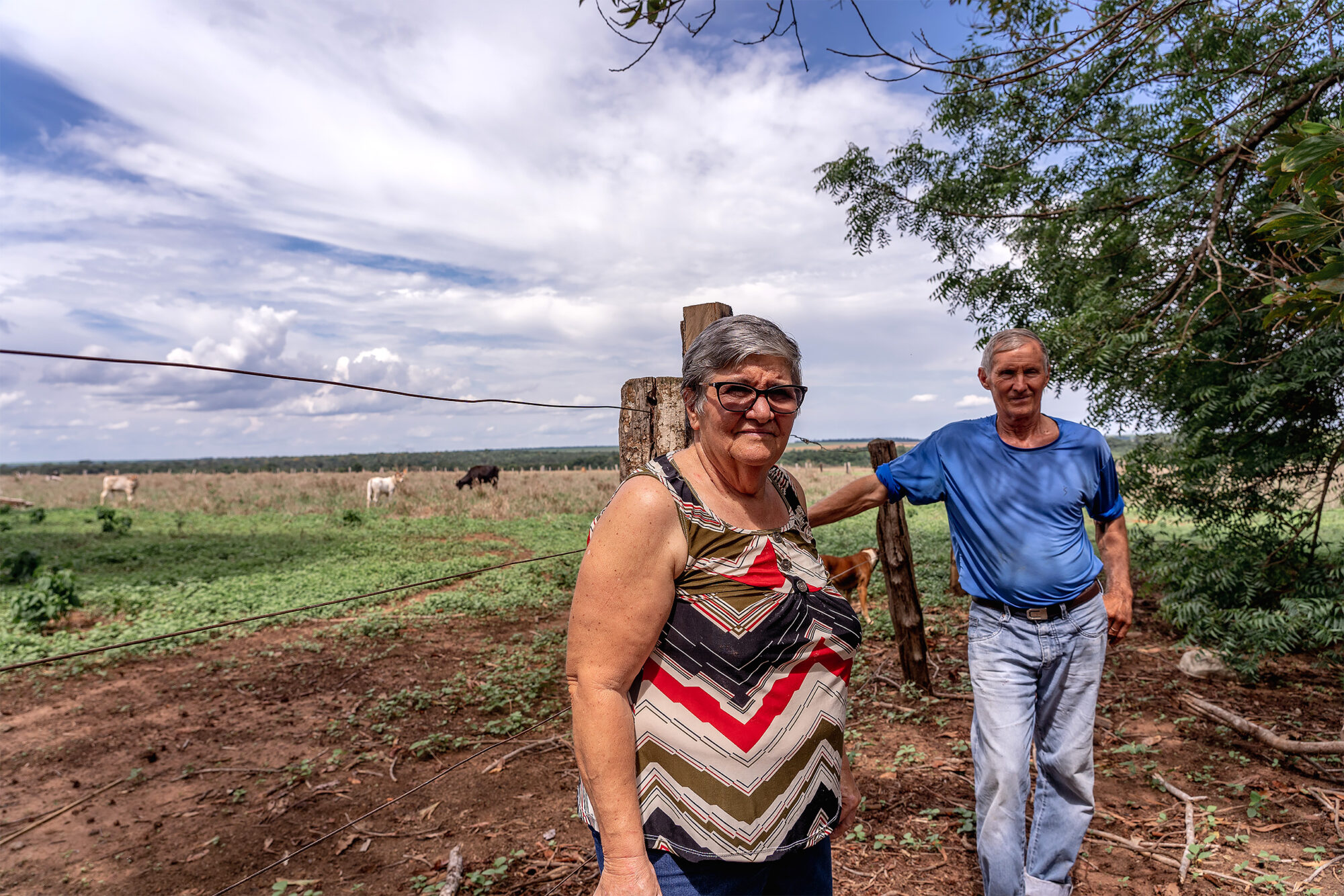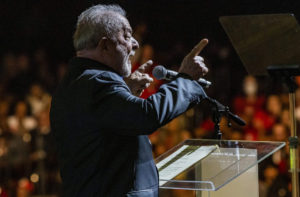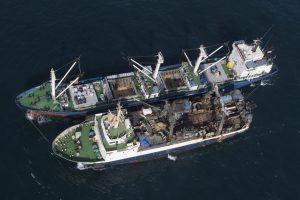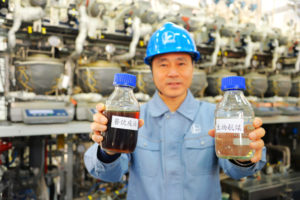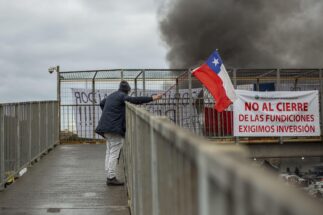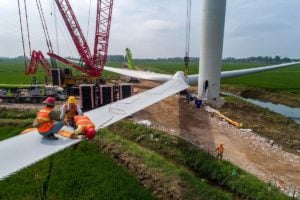Afaded sign on the corner between the MT-110 highway and a dirt road signals “Sector 1”. When I turn left, I enter the Pingo D’Água agrarian settlement in the municipality of Querência, Mato Grosso state. I drive around 10 kilometres alongside soybean plantations that stretch as far as the eye can see, until I reach one lot that stands out in this monotonous landscape.
The road towards the property is skirted by trees, the rare shade softening the intense heat of the region. I realise that they are rubber trees, typical of the Amazon, from which latex is extracted to produce rubber. Entering the property, I pass through cassava and fruit trees – pineapple, avocado and the cherry-like acerola – until I stop in front of a house surrounded by flowers.
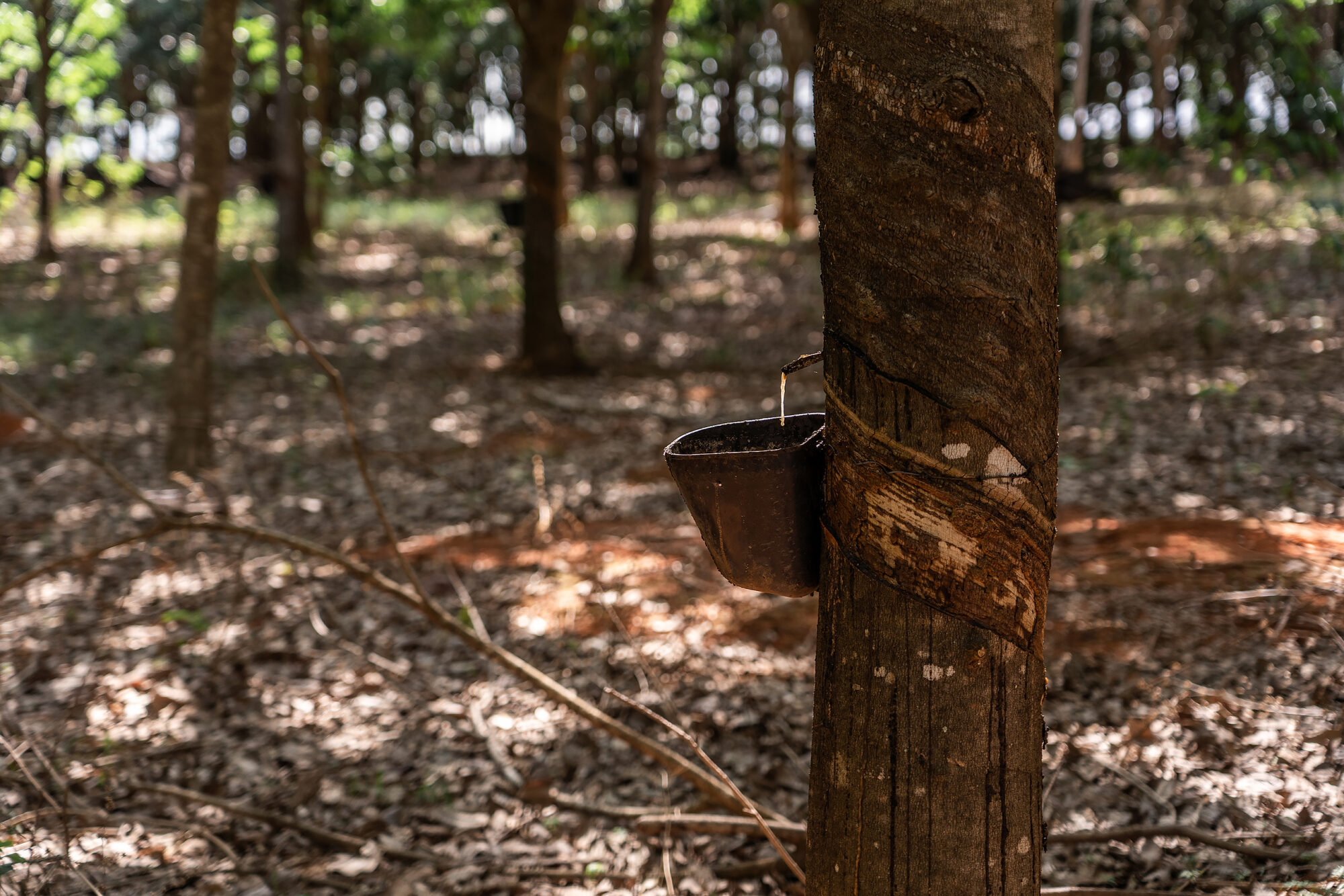
Danilo Pertile, 73, and his wife Evanir Pertile, 69, receive me on their large veranda. They tell me how the settlement, originally aimed at poor family farmers to produce mainly food crops, has been transformed over time. “It started with small plantations, then they expanded, and the small farmers sold their plots,” says Evanir. “Now, it is practically all soybean.”
Querência has almost everything that the soybean industry needs: flat land, good soil, infrastructure and the presence of major banks and traders, such as Bunge, Cargill and Amaggi. “What was lacking?” economist and biologist Rafael Barbieri asks. “Land. And where was there land? In the settlements.”
With agricultural land in the municipality becoming scarce, the soy industry has turned its sights on family farmers, who live in and work the land and typically bring in an annual income of less than 500,000 Brazilian reais (US$ 97,500), according to Barbieri, author of a study for the Amazon Environmental Research Institute (IPAM) on what has been happening in Pingo D’Água.
Soy grows in a field on deforested land in Querência (Image: Flávia Milhorance)
“Soybean has been occupying the settlements very aggressively, which is a great concern,” says Richard Smith, regional coordinator of IPAM, which aims to encourage alternative production chains. “Our mission is not to outdo soybean plantations, but to save family farming.”
Capital and soy producers commonly come from outside the region, sometimes from outside the country. Meanwhile, farming families have moved away from growing food or migrated to less expensive regions – or tried to resist the pressures.
“Soybean is making things harder and harder,” says Danilo, whose small farming business focuses on producing and selling a variety of fruits, cassava, rubber and heart of palm, a white vegetable harvested from palm trees. As well as real estate speculation, Danilo explains that, with fewer family farmers, the cooperative structures that used to support the settlement have weakened. Investments focus on soybean farming – dozens of storage silos have sprung up in Querência in recent years – while credit lines for smallholder farmers have dwindled.
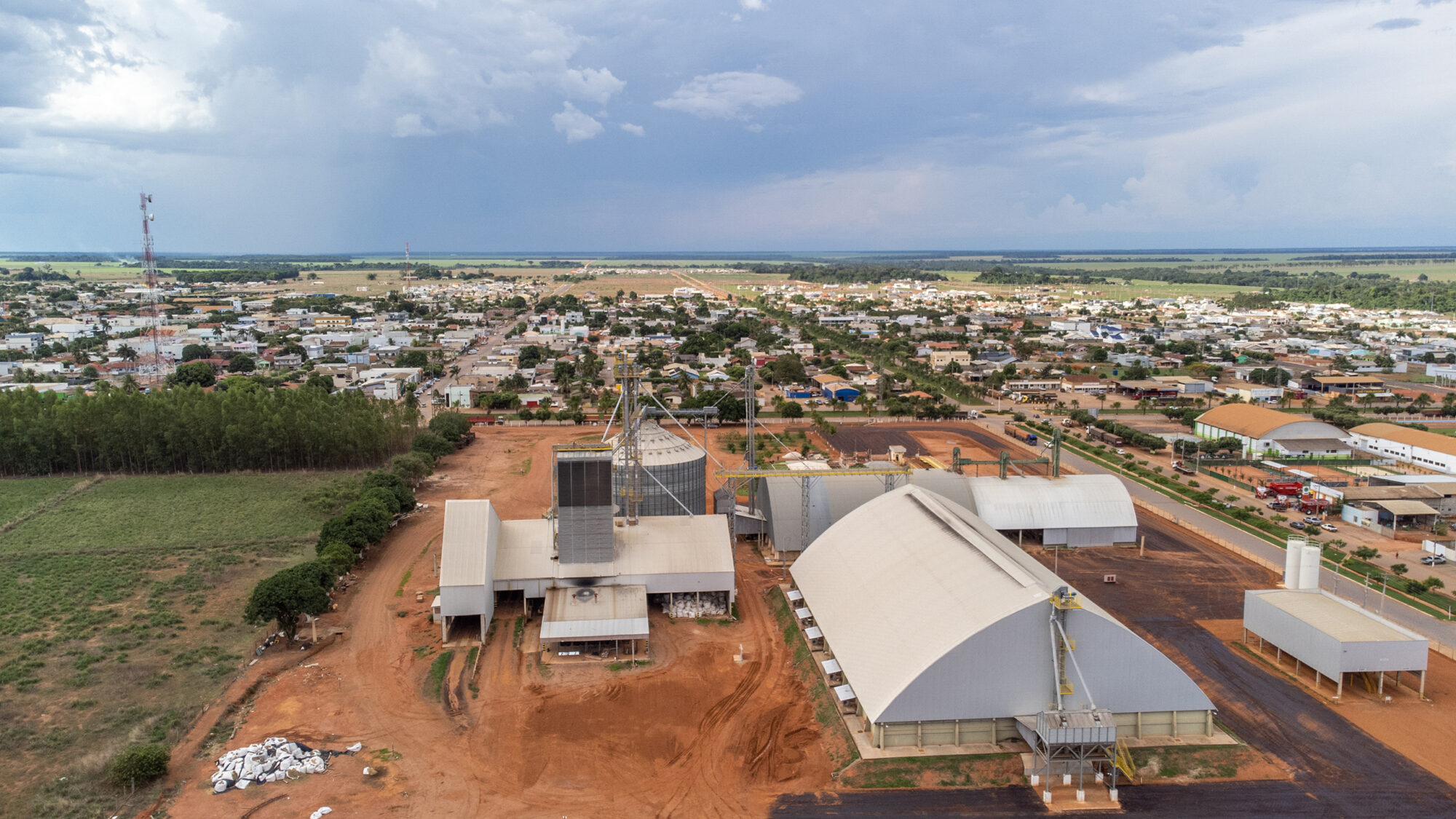
On top of this, planes fly over the nearby soybean fields spraying toxic agrochemicals. “They also pass over us,” says Danilo. Although the couple’s production is not organic, they say they apply as little pesticide as possible. With the intensification of aerial spraying, they have noticed some of their fruit species producing less than before or even, in Evanir’s words, “shrivelling to death.”
Lost forest
It was not always like this. The couple arrived in Querência two decades ago, leaving a disputed rural area in Brazil’s south to try a piece of land in the midwest. “It was almost all forest,” recalls Danilo. “There were just a few residents and cattle,” adds Evanir.
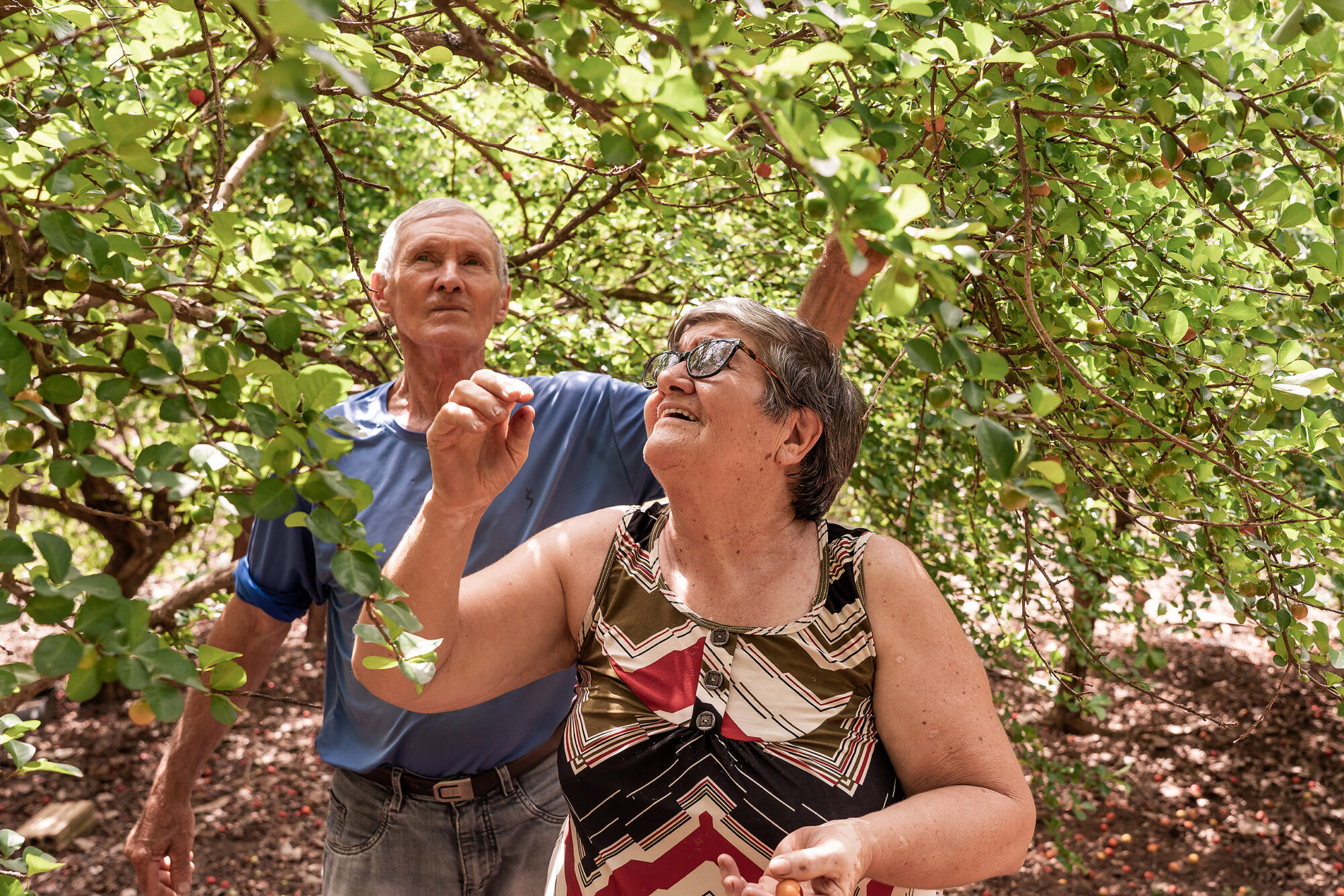
As in other areas of the Amazon, the National Institute for Colonisation and Agrarian Reform (INCRA), a federal government agency, has distributed land to farmers to boost the occupation of the region, where Indigenous peoples have inhabited the biome for millennia and, in many cases, been expelled from their territories. Created in 1970, during the era of Brazil’s military dictatorship, INCRA still settles small farmers on unproductive properties or unused public lands.
In 1998, INCRA distributed plots of land on a 40,000-hectare property to about 550 families, among them the Pertiles. In that year, pastures occupied only 4% of Pingo D’Água, according to our analysis based on the Mapbiomas platform. The rest was Amazon forest. Within just six years, cattle ranching had already taken over half the area, destroying the native forest with it. But the biggest transformation was yet to come.
Over the decades, federal government incentives for intensive agriculture and the progressive increase of exports, mainly to China, led to a huge expansion of soybean production spreading from southern to central Brazil. Several cities in the midwest grew in the wake of international market demand for soy.
Among them was Querência, which has been among the 10 largest soybean growers in Brazil for at least a decade. Soybean had already taken over most of the agricultural areas in the municipality – and soon it overflowed into the settlements.

In Pingo D’Água, soy cultivation progressively advanced until it overtook livestock in 2018, in terms of land area occupied. Since then, soybean fields have continued to expand as pastures and forests shrink. In 2021, soybean alone occupied more than half the settlement, with native forest remaining on less than 15%, according to data from Mapbiomas.
The phenomenon surprised Barbieri, since soybean is usually more viable in large areas – those over 200 hectares – where the gain in scale reduces the costs and risks associated with monoculture. But the example of Pingo D’Água is no longer an exception in the country: similar processes have occurred in other agro-export hubs, including in other settlements around Querência.
Challenge to food production
Family farmers play an important role in Brazil’s food supply. Although the exact extent of their participation is not clear, they are responsible for the majority of production of vegetables, fruits, cow’s milk and meat (excluding beef and chicken), according to our analysis of the 2017 Agricultural Census, the most recent available. But the number of properties occupied by family farming has decreased by 9.5% compared to 2006.
This means that the gains soy is making on smallholder farming raises food security concerns. Around 60% of Brazilian soy is exported, according to data from the National Supply Company (CONAB), a state agricultural organisation. The beans that remain in Brazil aren’t consumed directly by humans, in the form of tofu or soy milk, for example, according to a survey by the UN Food and Agriculture Organization, but are mainly used for animal feed and biodiesel.
On several occasions during his election campaign in 2022, President Luiz Inácio Lula da Silva advocated encouraging family farming as a strategy to combat the increasing hunger spreading across Brazil. According to recent estimates, more than 33 million Brazilians do not have enough to eat every day. At an event in September, shortly before the first round of elections, Lula said that his plan would guarantee “healthy, better quality and cheaper food.”
As soon as he assumed the presidency in January, Lula created the Ministry of Agrarian Development and Family Agriculture, which will be responsible for managing INCRA and policies to encourage small farmers. Previously, these functions fell under the Ministry of Agriculture.
But the president will face opposition. The changes have already displeased the rural caucus, a grouping which brings together around 280 members of congress linked to agribusiness. “What worries us today is how this reorganisation of the ministries will look,” its leader, Pedro Lupion, said recently. “Unfortunately, the Ministry of Agriculture has been weakened.” According to Lupion, the separation of the management of family agriculture and the medium and large producers “compromises the growth strategy” of the agro-industry.
Beyond this departmental reform, no concrete plan has yet been launched for either small or large producers. One of the possibilities under discussion is the creation of a fund to improve the supply of credit for family farming – one of the main challenges small farmers face.
A different future
Sitting on the floor of the veranda, four young people rest from their work in the field while listening to the Pertiles talk about their attachment to the land, and their concern for the future of the settlement. “In a few years, who is going to produce food if there is no family farming?” Evanir asks.
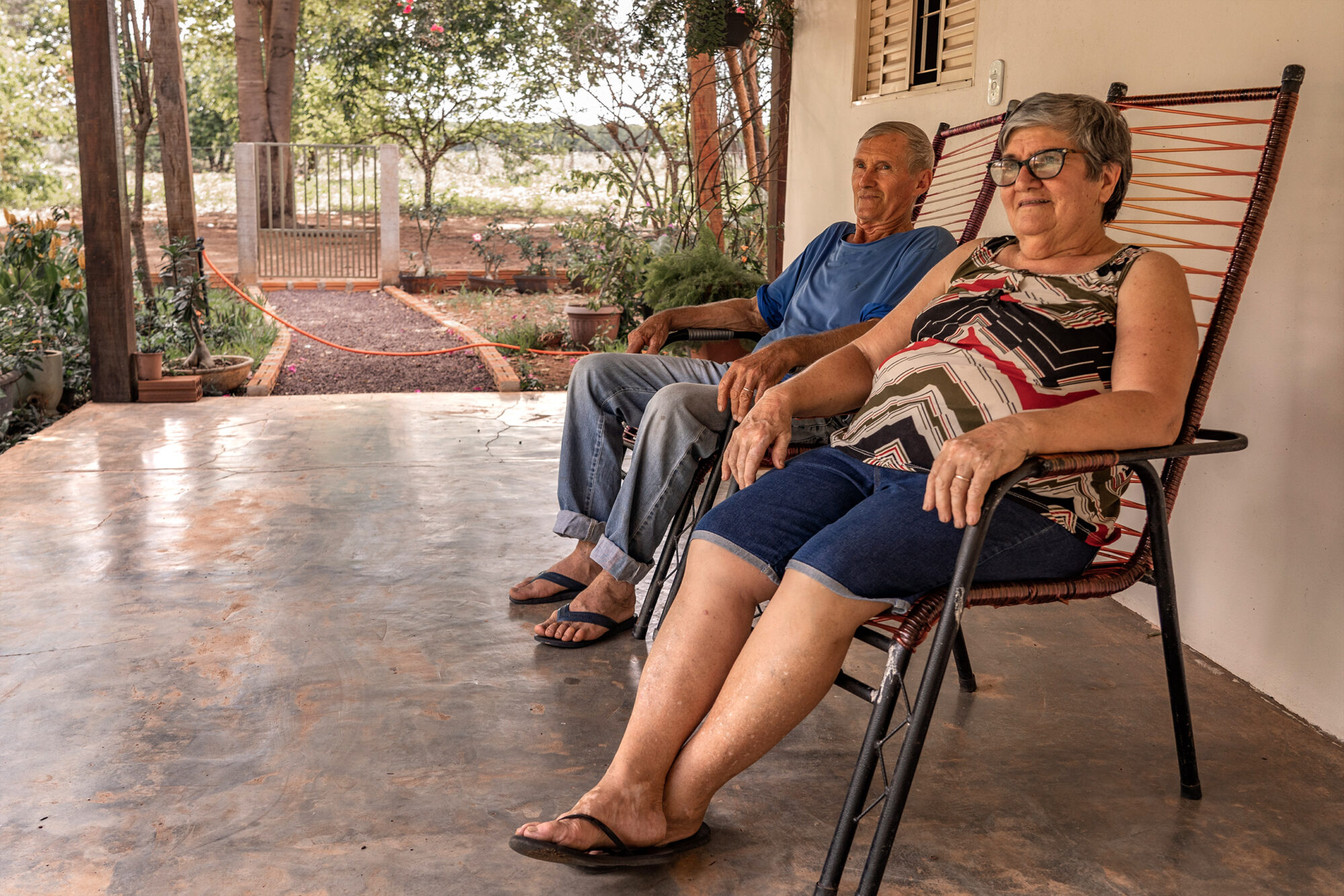
Elias da Silva Benício, 22, is the son of a family farmer whose story is similar to that of Danilo and Evanir. But his own plans are different. “When my father dies, the next day I will plant soybean,” he says bluntly, drawing laughs and agreement from the other young people. “That’s what makes money, isn’t it?”
Benício talks about how growing vegetables and fruit “is a lot of work, but does not provide an income.” From family farming, he says, “there is little left over, but from soybeans, there is a lot.” The Pertiles’ disappointment is obvious.
But the young people’s perception that soybean is a quick way to make money isn’t borne out by the reality. Based on interviews at Pingo D’Água, Barbieri says that most settlers who took up soybean farming on their own, even with experience, acquired debts that are hard to pay off.
The high cost of soybean production reduces the chances of profit for small producers and exposes them to risks. In the absence of public credit, soy traders and intermediaries offer technical assistance, product purchase guarantees and easy financing. This seems appealing to farmers, but purchase prices fall short of their expectations and interest rates are too high.
When my father dies, the next day I will plant soybean. That’s what makes money, isn’t it?
In debt, producers form partnerships, lease or sell their land to farmers with more capital inside and outside the settlement. Since INCRA forbids settlers from leasing and limits the sale of lots only to those with definitive title deeds, most farmers enter into partnership contracts.
Soybean grower Jonathan Ben managed to sell his produce from the previous year to a local middleman, but he fears for the fate of this year’s crop, whose green shoots are beginning to emerge from his 62-hectare plot.
“We plant because we have debt to pay,” says Ben, holding his daughter on his lap in front of his house. “But you’re not able to sell anything. Everything here is embargoed.”
Embargoes from IBAMA, the government’s environmental enforcement agency, on the purchase of soy from illegally deforested land have been introduced in an attempt to protect the Amazon rainforest. But farmers in the settlement have been unwittingly caught up in the complex bureaucracy. This further limits access to credit and the sale of products. When we checked the database of IBAMA, we found 97 active embargoes in Pingo D’Água, applied between 2009 and 2019 – none of them in the name of Ben or Pertile.
Ben’s yard has a few cassava trees, bananas and some cattle for his own consumption. His income is entirely dependent on the soybean business – both through what he plants himself and through the services he provides with his tractor and combine harvester, huge machines parked next to his house. To make a living, he says, “you have to know how to work, and you have to have machinery, which is expensive.”
Ben is following in the footsteps of his father, with whom he emigrated from Paraná, in the south, to Querência in 2003. For him, soybean farming is less linked to the current market boom and more to habit: “Since the age of 11, 12, we have always worked on this crop.”
Habit also keeps the Pertiles in a business that faces increasing barriers. “We learned to plant from a very young age,” says Evanir, who fears the longer-term impacts of soybean on her crop. “We are getting by for the time being, but we do not know how much longer we will be able to produce.”
